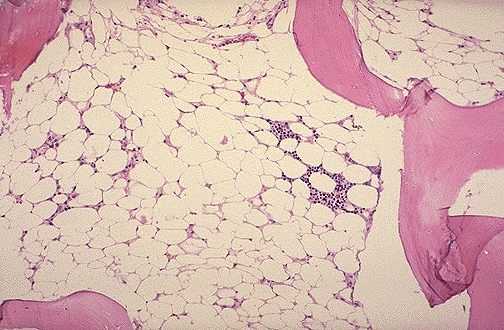Aplastic anemia pathophysiology: Difference between revisions
Nazia Fuad (talk | contribs) |
Nazia Fuad (talk | contribs) |
||
| Line 8: | Line 8: | ||
==Pathophysiology== | ==Pathophysiology== | ||
=== Physiology === | |||
The normal physiology of bone marrow can be understood as follows:<ref name="pmid2406826">{{cite journal |vauthors=Hays K |title=Physiology of normal bone marrow |journal=Semin Oncol Nurs |volume=6 |issue=1 |pages=3–8 |date=February 1990 |pmid=2406826 |doi= |url=}}</ref> | |||
* '''Bone marrow''' is a spongy tissue, found within the spongy or cancellous portions of bones | |||
* It is higly vascularized and richly innervated | |||
* Bone marrow is the primary site of hematopoiesis | |||
* It is composed of hematopoietic cells, marrow adipose tissue, and stromal cells. | |||
* The hematopoiesis is controlled by a various regulatory mechanisms, including growth factors. | |||
* The normal bone marrow structure can be damaged or displaced by aplastic anemia, malignancies or infections. | |||
* This leads to decrease production of blood cells and blood platelets. | |||
. | |||
=== Pathogenesis === | |||
* The exact pathogenesis of [disease name] is not completely understood. | |||
OR | |||
* It is understood that [disease name] is the result of / is mediated by / is produced by / is caused by either [hypothesis 1], [hypothesis 2], or [hypothesis 3]. | |||
* [Pathogen name] is usually transmitted via the [transmission route] route to the human host. | |||
* Following transmission/ingestion, the [pathogen] uses the [entry site] to invade the [cell name] cell. | |||
* [Disease or malignancy name] arises from [cell name]s, which are [cell type] cells that are normally involved in [function of cells]. | |||
* The progression to [disease name] usually involves the [molecular pathway]. | |||
* The pathophysiology of [disease/malignancy] depends on the histological subtype. | |||
== Genetics == | |||
[Disease name] is transmitted in [mode of genetic transmission] pattern. | |||
OR | |||
Genes involved in the pathogenesis of [disease name] include: | |||
* [Gene1] | |||
* [Gene2] | |||
* [Gene3] | |||
OR | |||
The development of [disease name] is the result of multiple genetic mutations such as: | |||
* [Mutation 1] | |||
* [Mutation 2] | |||
* [Mutation 3] | |||
== Associated Conditions == | |||
== Gross Pathology == | |||
On gross pathology, [feature1], [feature2], and [feature3] are characteristic findings of [disease name]. | |||
== Microscopic Pathology == | |||
On microscopic histopathological analysis, [feature1], [feature2], and [feature3] are characteristic findings of [disease name] | |||
{| align="right" | |||
|[[File:Aplasticanemia.jpg |400px|thumb|right|Image yellow fat ladden marrow https://www.wikidoc.org/index.php/File:Aplasticanemia.jpg source:By Wmheric [CC BY-SA 3.0 (https://creativecommons.org/licenses/by-sa/3.0)] [Public domain], from Wikimedia Commons]]] | |||
|} | |||
==References== | ==References== | ||
Revision as of 15:02, 15 August 2018
|
Aplastic anemia Microchapters |
|
Diagnosis |
|---|
|
Treatment |
|
Case Studies |
|
Aplastic anemia pathophysiology On the Web |
|
American Roentgen Ray Society Images of Aplastic anemia pathophysiology |
|
Risk calculators and risk factors for Aplastic anemia pathophysiology |
Editor-In-Chief: C. Michael Gibson, M.S., M.D. [1]; Associate Editor(s)-In-Chief: Priyamvada Singh, M.D. [2] Nazia Fuad M.D.
Please help WikiDoc by adding content here. It's easy! Click here to learn about editing.
Overview
Pathophysiology
Physiology
The normal physiology of bone marrow can be understood as follows:[1]
- Bone marrow is a spongy tissue, found within the spongy or cancellous portions of bones
- It is higly vascularized and richly innervated
- Bone marrow is the primary site of hematopoiesis
- It is composed of hematopoietic cells, marrow adipose tissue, and stromal cells.
- The hematopoiesis is controlled by a various regulatory mechanisms, including growth factors.
- The normal bone marrow structure can be damaged or displaced by aplastic anemia, malignancies or infections.
- This leads to decrease production of blood cells and blood platelets.
.
Pathogenesis
- The exact pathogenesis of [disease name] is not completely understood.
OR
- It is understood that [disease name] is the result of / is mediated by / is produced by / is caused by either [hypothesis 1], [hypothesis 2], or [hypothesis 3].
- [Pathogen name] is usually transmitted via the [transmission route] route to the human host.
- Following transmission/ingestion, the [pathogen] uses the [entry site] to invade the [cell name] cell.
- [Disease or malignancy name] arises from [cell name]s, which are [cell type] cells that are normally involved in [function of cells].
- The progression to [disease name] usually involves the [molecular pathway].
- The pathophysiology of [disease/malignancy] depends on the histological subtype.
Genetics
[Disease name] is transmitted in [mode of genetic transmission] pattern.
OR
Genes involved in the pathogenesis of [disease name] include:
- [Gene1]
- [Gene2]
- [Gene3]
OR
The development of [disease name] is the result of multiple genetic mutations such as:
- [Mutation 1]
- [Mutation 2]
- [Mutation 3]
Associated Conditions
Gross Pathology
On gross pathology, [feature1], [feature2], and [feature3] are characteristic findings of [disease name].
Microscopic Pathology
On microscopic histopathological analysis, [feature1], [feature2], and [feature3] are characteristic findings of [disease name]
 |